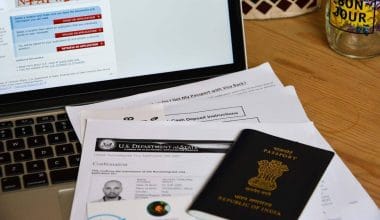International students may require a financial sponsor when applying for a student visa in the United States. If you intend to study in the United States as an international student, you must apply for a student visa.
However, the application process for your student visa may differ depending on the program you have applied for and the type of sponsorship required for your studies. Your student visa may also depend on the country of your research.
Either way, a student visa sponsorship can primarily help you in the student visa application process in terms of funds. Have you been looking for a student visa sponsorship but need to know how to start?
This article would serve as a complete guide, showing you how and who can help you with a student visa sponsorship. Let’s get started.
Table of contents
- What Is a Student Visa Sponsorship?
- What Are the Different Types of Student Visas Sponsorship?
- Can I Get a Student Visa Sponsorship?
- What Forms Do I Need for Student Visa Sponsorship?
- Requirements for Student’s Visa Sponsorship
- Who Can Sponsor an International Student?
- Conclusion
- References
- Recommendations
What Is a Student Visa Sponsorship?
A student visa is a non-immigrant class visa that allows international students to study at the Student and Exchange Visitor Program (SEVP)-certified universities or colleges in the United States. The SEVP is a Department of Homeland Security program that collects vital information about international students.
The program also provides certification and oversight to accredited institutions, as well as advice to institutions and students on visa status as international students and how to maintain eligibility.
When applying for a student visa, you must demonstrate that you can cover your tuition and living expenses in the United States. You need a student visa sponsorship if you cannot hide it. Grants, family members, government organizations, and private companies are some examples of financial sponsors for students.
A SEVP-certified US institution must accept you before you can apply for a student visa. Once accepted, you must decide which type of student visa is best for your situation, as each has its own set of conditions and requirements.
What Are the Different Types of Student Visas Sponsorship?
The type of student visa you require is determined by the program you are enrolled in and your tuition sponsorship. Here are the two most common types of student visas for international students in the United States:
Student Visa for F-1 Student
This is the most common student visa type, allowing you to study at SEVP-approved institutions. The following are the primary requirements for F-1 visas:
- Students are permitted to work on campus without a work permit but must obtain one at an off-campus job or internship.
- Dependents of F-1 students may not work but may enroll in part-time study programs.
- F-1 graduates may apply for Optional Practical Training (OPT) or Curriculum Practical Training (CPT) to work or train in the United States for up to 12 months after graduation. Graduates of STEM-related degrees can request an additional two years.
- If no extensions are granted, F-1 students must leave the United States within 60 days of the completion of their program.
Student Visa J-1
You can participate in work- and study-related exchange programs at US colleges and universities with a J-1 student visa. The United States Department of State’s Bureau of Educational Affairs must accredit the institute to which you have applied.
The following requirements apply to J-1 visas:
- Participating in any work (on or off campus) causesTaking part a work permit.
- Dependents of J-1 students may work and study both part-time and full-time.
- J-1 students who have graduated are eligible to apply for Academic Training (AT) opportunities in a field related to their studies.
- If no extensions are granted, J-1 students must return to their home countries within 30 days of the program’s end date. Before returning to the United States, students must also live in their home country for two years.
SEE ALSO: How To Get a Student Visa In Italy | Step-by-Step Procedures
Can I Get a Student Visa Sponsorship?
You certainly can! When you apply for a student visa, you can receive financial aid from your university or college, the government, or private sources such as friends or family.
You may be required to provide personal proof of the source sponsoring your student visa. Depending on the sponsor, you may be required to complete specific forms to disclose the sources of your financial support.
What Forms Do I Need for Student Visa Sponsorship?
You must get an I-20 or DS-2019 form depending on your student visa. The F-1 visas require the I-20 form, while the J-1 visas require the DS-2019 form.
Your I-20 or DS-2019 will be sent to you once your university or college confirms receipt of your payment. J-1 students must work with their program sponsor’s Responsible Officer to obtain their DS-2019 form, whereas F-1 students receive their I-20 from a Designated School Official.
Your I-20 or DS-2019 form contains critical information for your degree, such as the program you intend to study, program start and end dates, funding sponsors, and other personal information you provided when applying. The I-20 or DS-2019 forms are critical because they prove your enrollment at a SEVP-certified institution.
The same information is entered into the Student and Exchange Visitor Information System when your I-20 or DS-2019 is issued (SEVIS). SEVIS is a SEVP database that stores and maintains information about international students online. You must pay the I-901 SEVIS fee as part of the student visa application process.
Requirements for Student’s Visa Sponsorship
You must provide evidence of your ability to pay your university tuition and fees for at least 12 months as part of the requirements for your student visa. If your academic program lasts less than a year, say; nine months, you only need to show funding for that period.
Typically, this entails bank statements from your sponsor (or yourself if you are paying for your program with your own money). Depending on the university, you may also be required to provide a list of total assets.
While you are not expected to pay for every year of your program right away, it is critical to show that you have sufficient funding without relying on employment in the United States during your studies.
The type of financial sponsors for eligible students to support your program is determined by the student visa you require. You can use personal funds, assets, or property that can be converted into cash or funds from other people (such as friends and family) or organizations to sponsor an F-1 student visa for an international student. A non-profit or educational sponsor who is not related to you can only sponsor J-1 visas.
Remember that if family members sponsor international students, they must also submit Form I-134, which states their consent to fund your studies and living expenses, besides bank and asset statements.
Individuals seeking funding from non-family members must submit Form I-134 and a written statement explaining why they are paying for their studies. Both forms are available on the website of the United States Citizenship and Immigration Services.
SEE ALSO: How To Get Student Visa Bahamas In 2024
Related Article: How To Apply For a Student Visa In France | Interview, Requirements, Permit
Who Can Sponsor an International Student?
Many nonprofits, private organizations, and the US and international governments may provide financial help to international students. This type of help is typically difficult to come by. Some organizations may provide financial assistance to international students pursuing an education.
Funding from the US Government
It is uncommon to find government support in the United States. Many financial aid programs, such as Pell grants, are only available to citizens of the United States. Some companies may have funds available for students. This could come from the US Department of State. In addition, the US Agency for International Development may assist.
Some students may get funding in this manner. These programs manage the application process for students. They may also have stringent rules regarding the school of choice. It may also restrict how the funds can be used.
According to Education USA, students who qualify may get up to 100% of their tuition paid for. Looking into either of these programs for financial help may be worthwhile. This is usually an excellent place to start.
Funding from an International Government
Some students may obtain funding from their home country’s government. This varies considerably. Some countries may contribute to the cost of studying abroad for their citizens. This could be done for practice.
It is sometimes done to encourage students to pursue more advanced education. They may also provide it if they do not have a program that corresponds to the student’s interests.
If these programs are available, a country’s Department of Education usually offers them. A Ministry of Education may also provide it occasionally. They may assist in the formation of partnerships with schools in the United States.
These collaborations have the potential to be highly profitable. If these connections exist, students may be eligible for significant funding. This could cause education to be provided for free or at a reduced cost.
Sponsorship for International Students from Private Organizations
Private organizations are another source of sponsorship for international students. Many companies may look for international students to fill key positions. They may also provide them with scholarships. They usually want to foster international relations.
Some organizations may open up new channels for untapped talent. Private companies may do this for various reasons, including potential employers.
Companies will frequently do this if they link their interests to a country’s goals or economics. They may also establish stringent guidelines for this. Before selecting this option, students should learn about the company’s goals. They may have particular plans for the student once they have completed their course of study. Missions and values should align with the purposes of the students.
These private organizations usually set the ground rules for where these funds can come from. It also specifies how the funds will be used. Conditions can sometimes bind a student to a private organization for years. They may influence many aspects of the student’s experience.
Some organizations may cover all the student’s expenses, whether you are a part-time or full-time student. This includes tuition and book expenses. It could also include funds for relocating to the United States. Some programs may include internships as part of the curriculum. If this is the case, the J1 visa rules remain in effect.
SEE ALSO: How to Get a Student Visa in Saudi Arabia | 2024
Sponsorship for International Students from Nonprofit or Other Organizations
Some non-profit organizations may assist with these expenses. They may provide financial help to international students who wish to study in the United States. These are typically companies based outside of the United States. Some may do so if they will benefit from improved global travel or cultural exchange. Many non-profit organizations have a specific goal or help in mind. They should teach these rules to students.
They should learn about the organization and its goals. Some of these programs may be restricted. Many people may offer to cover the entire cost of the student’s education.
Books, fees, and tuition may be included. Some will even pay for your rent. They may even provide a stipend to help with expenses. These organizations can be challenging to locate.
You can get some from the education department. Students frequently require a working relationship with the organization. This may open the door for them to receive this type of assistance.
Conclusion
International students who want to study full-time abroad have several options. Many students must pay for their college education themselves. International student sponsorship could help cover the high costs of higher education.
Many student loan programs and grants in the United States are typically only available to citizens of the United States. Some may provide opportunities for students, but these are usually provided by someone other than the government. Financial support can come from a variety of sources. The main advantage is that the sponsor usually covers some or all of the student’s expenses.
References
- port.ac.uk– International student visa sponsorship
- blog.myrawealth.com– Student visas
- globalinternships.com– International student visa sponsorships
- Westminster.ac.uk– International visas
- gov. uk– student visa sponsor guidance
Recommendations
DISCLOSURE: This post may contain affiliate links, meaning when you click the links and make a purchase, we receive a commission.






4 comments
Comments are closed.